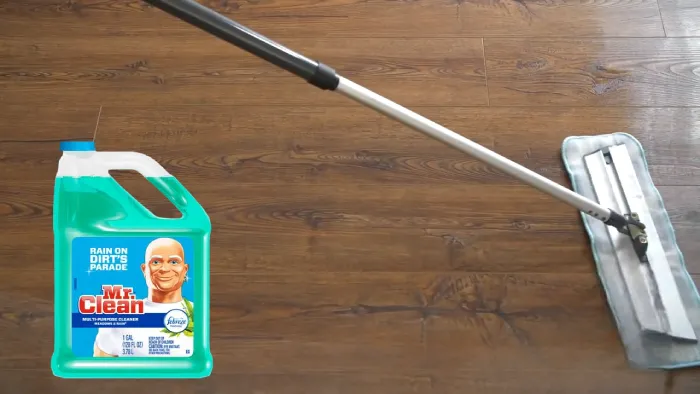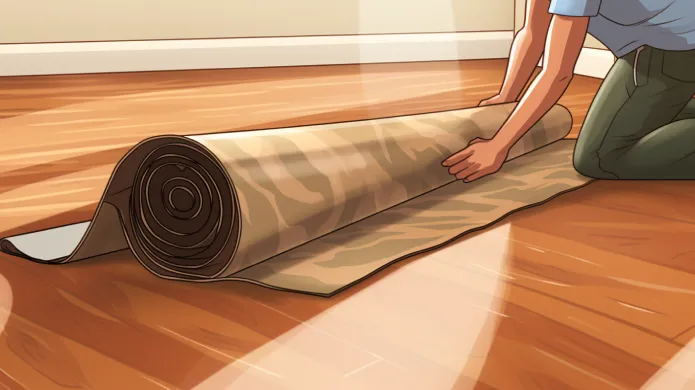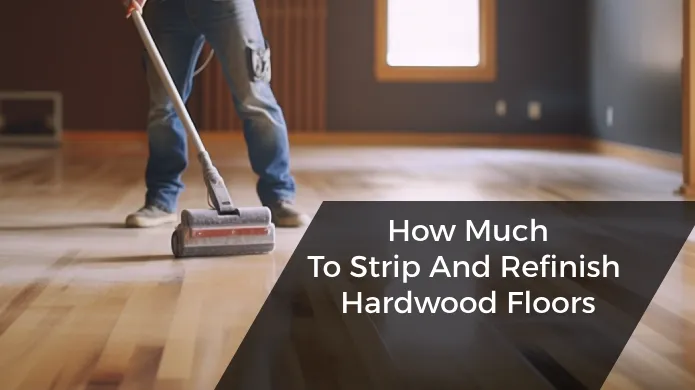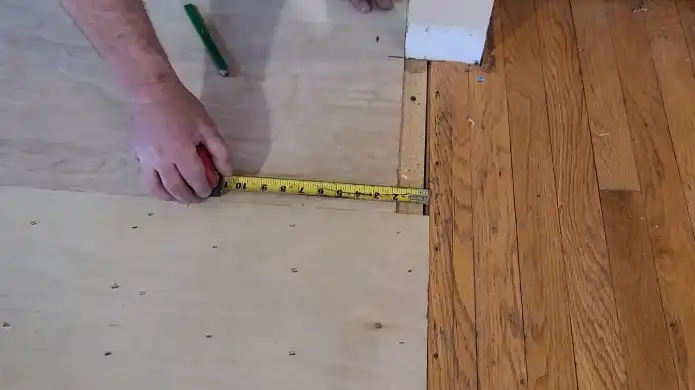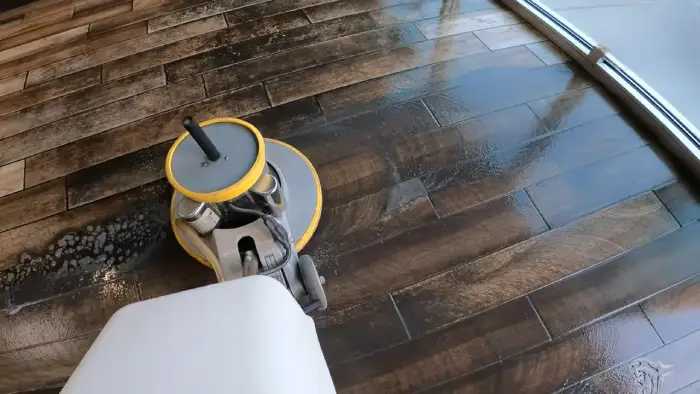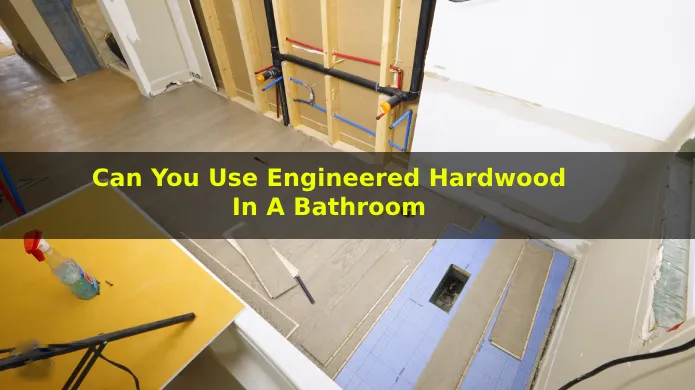You can expect laminate floors to last 15 to 25 years, sometimes over 30 with high-quality options and proper care. Their durability depends on thickness, AC rating, and installation quality.
Avoid moisture damage, use gentle cleaning, and maintain stable humidity to extend life. Frequent spills, improper installation, or heavy wear shorten lifespan. With good maintenance and protective measures, your floors stay in great shape longer.
Keep exploring to discover how to maximize your flooring’s longevity and performance.
Key Takeaways
- Laminate floors typically last 15 to 25 years, with high-end options exceeding 30 years under proper maintenance.
- Durability depends on AC rating, wear layer thickness, installation quality, and environmental conditions.
- Excess moisture, improper cleaning, and poor subfloor preparation significantly reduce laminate flooring lifespan.
- Signs of needed replacement include warping, deep scratches, gaps wider than 1/8 inch, and persistent creaking or stains.
- Proper maintenance, UV protection, and use of protective pads can maximize laminate flooring longevity.
Typical Lifespan Range of Laminate Flooring
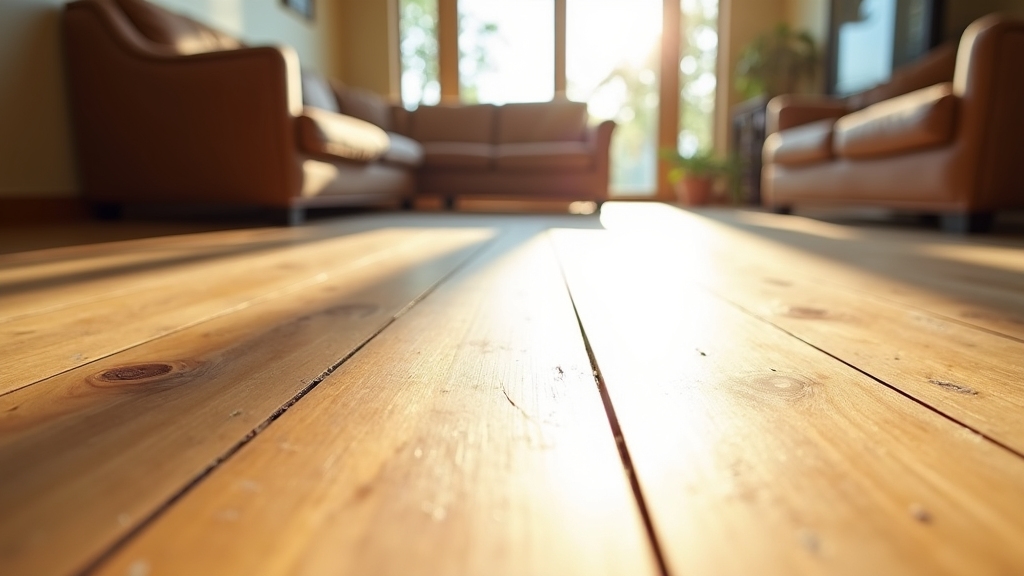
While laminate flooring typically lasts between 15 to 25 years, its actual lifespan depends on factors like quality, installation, and maintenance.
Laminate flooring typically lasts 15 to 25 years, depending on quality, installation, and upkeep.
You should know that high-end laminate can last up to 30 years or more with excellent care, while lower-quality options might start showing wear in as little as 10 years.
Unlike hardwood, laminate can’t be refinished, so once it’s worn out, replacement is necessary. This contrasts with hardwood’s refinishing capability that extends its lifespan.
You’ll also want to contemplate that heavy foot traffic and moisture exposure can shorten its life due to swelling or warping. Keeping your laminate clean and dry, and properly installing it on a stable subfloor, helps maximize durability.
Regular sweeping or vacuuming prevents scratches and protects the surface. Laminate offers a cost-effective, moderately long-lasting flooring solution, especially suitable for residential areas with average traffic.
Quality and Thickness Effects on Durability
When it comes to laminate flooring, you’ll notice that the wear layer thickness and the abrasion class (AC) rating are super important for durability. Higher AC ratings mean better resistance to scratches and impacts, which is definitely something you want in a busy home.
Now, let’s talk about thickness. Choosing thicker planks, especially those with high-density fiberboard cores, really does make a difference. It not only boosts durability but also enhances stability and moisture resistance.
Additionally, laminate floors with advanced click-lock systems provide easier installation and a more secure fit, contributing to the floor’s overall longevity. To ensure a smooth and lasting installation, using the correct transition strips when joining laminate with other flooring types is essential.
Wear Layer Importance
Because the wear layer acts as the laminate floor’s primary defense against daily damage, its quality and thickness directly impact your floor’s durability and lifespan.
Made from tough materials like aluminum oxide or melamine resin, this transparent coating resists scratches, stains, fading, and chemical exposure.
Thickness, measured in mils, ranges from 4 to 40; higher mil ratings mean greater protection. For light residential use, 4 mil suffices, but homes with pets or heavy traffic need at least 12 mil.
Commercial areas demand 20 mil or more. Wear layers rated AC3 (20-25 mil) last 15-20 years, while AC4 (30-40 mil) can exceed 25 years. Testing standards guarantee resistance to abrasion, indentation, chemicals, and UV damage.
Additionally, the wear layer is the first line of defense against daily wear and tear, making it crucial for long-lasting flooring.
Regular maintenance, including proper cleaning methods like gentle sweeping or vacuuming, helps preserve the wear layer and extends your floor’s life.
Core Thickness Benefits
Beyond the wear layer, the core thickness of your laminate floor plays a significant role in its durability and overall performance. Thicker cores, typically between 10mm and 12mm, provide enhanced structural stability, reducing flexing and protecting locking mechanisms.
This means your floor resists dents, impacts, and everyday wear better. Additionally, core thickness helps mitigate issues caused by temperature fluctuations which can otherwise lead to warping or buckling.
Plus, a thicker core improves moisture resistance, helping prevent swelling or warping in damp areas. Consider these core thickness benefits: increased rigidity reduces hollow sounds and plank separation. Better resistance to heavy furniture pressure and dropped objects.
Enhanced moisture resistance for longer-lasting stability. Additionally, thicker cores contribute to noise reduction, creating a quieter and more comfortable living environment.
Choosing a laminate with a thicker, high-quality core ensures your floor stays strong and comfortable, especially in high-traffic or moisture-prone spaces.
Abrasion Class Ratings
When selecting laminate flooring, understanding Abrasion Class (AC) ratings helps you match durability to your space’s needs. AC ratings range from AC1 to AC6, reflecting resistance to abrasion, impact, staining, fading, and burns.
For residential areas, AC1 suits light traffic like closets, while AC3 and above handle busy living rooms and kitchens. AC3 and above are considered suitable for higher-traffic areas, providing reliable performance in busy household spaces.
Maintaining floors with regular cleaning methods extends their lifespan and appearance. Commercial spaces demand AC4 or higher, with AC6 built for extreme wear, such as airports.
Wear layer thickness, measured in mils, also matters. A minimum of 12 mils guarantees durability in high-traffic zones. This layer contains aluminum oxide particles that resist scratches and scuffs.
Balancing cost and durability is key; choosing a high AC rating in low-traffic areas wastes money, while too low a rating risks premature wear.
Importance of Proper Installation
Hey there! So, when it comes to installing laminate flooring, having a level subfloor is super important. It really helps your laminate planks lay flat and lock together securely. If you skip this step, you might end up with uneven wear over time, and nobody wants that!
Additionally, neglecting moisture control can lead to issues like warping and buckling that damage the floor’s integrity.
Now, let’s talk about installation techniques. It’s crucial to pay attention to things like maintaining those expansion gaps and getting the plank alignment just right. These little details really help keep your floor’s structural integrity intact, which is a big deal!
And don’t forget about moisture barriers! Using them can protect your floor from dampness that could lead to warping or other damage. Trust me, taking these steps can really extend the lifespan of your floor!
Before you even start, make sure to acclimate laminate planks to the room’s temperature and humidity for at least 48 hours to prevent future expansion or warping.
Level Subfloor Necessity
A level subfloor plays an essential role in guaranteeing your laminate flooring fits together seamlessly and lasts longer.
Uneven surfaces cause shifting, gaps, and premature wear, compromising the floor’s durability and potentially voiding warranties.
Industry standards require the subfloor to be level within 3/16 inch over 10 feet, so addressing irregularities beforehand is critical. Using laser levels or straightedges helps verify this flatness accurately.
To maintain a solid foundation, focus on these key points:
- Use leveling compounds for minor dips; call a pro for major unevenness.
- Remove any existing flooring and fill grout lines for a smooth surface.
- Check moisture levels and guarantee proper vapor barriers are in place.
Proper subfloor preparation reduces stress on locking systems, preventing cracking and extending your laminate floor’s lifespan. Vacuum the entire surface thoroughly to ensure the subfloor is clean and dry before installation.
Installation Techniques Matter
Although selecting quality laminate flooring is important, the installation techniques you use have a significant impact on its performance and lifespan.
Start by dry fitting several rows to test layout and adjust plank placement for a balanced pattern. Begin at the straightest wall, maintaining a consistent 1/4-inch expansion gap around the perimeter to allow natural movement. Properly leaving these gaps is essential to prevent issues like buckling or warping.
Use the click-lock method properly: insert planks at a 20-30 degree angle, secure with tapping blocks and rubber mallets, and carefully fit the last row with a pry bar. Always cut with the finished side facing up for clean edges.
Insert spacers to keep expansion gaps uniform, preventing buckling or warping. Prepare tools and underlayment, acclimate planks for 48+ hours, and level the subfloor thoroughly to ensure durability and a smooth finish.
Laminate flooring often features a floating system that allows it to expand and contract without nails or adhesives, which is crucial for longevity and avoiding damage.
Moisture Barriers Role
Mastering installation techniques sets a strong foundation, but moisture control plays an equally vital role in protecting your laminate floor.
Without a proper moisture barrier, water vapor from the subfloor can cause warping, swelling, and even mold growth. This is especially essential when installing over concrete or in high-humidity areas.
Checking for moisture issues and ensuring the subfloor is dry before installation significantly reduces the risk of damage. Subfloor preparation Proper installation of a vapor barrier meeting ASTM E-1745 standards helps create a continuous moisture-resistant layer that protects your flooring’s longevity.
To guarantee your floor’s longevity, you need to:
- Use a vapor barrier or plastic sheeting underlayments to block moisture effectively.
- Seal plank edges with waterproof sealant to prevent water infiltration.
- Overlap and tape seams in moisture barriers for continuous protection.
Maintenance Practices to Extend Floor Life
When you maintain your laminate flooring with consistent care, you substantially extend its lifespan and preserve its appearance.
Start with a daily routine: sweep or vacuum using a soft-bristle broom or soft brush attachment to remove dirt and pet hair, preventing microscopic scratches. Use minimal moisture when damp mopping to avoid water infiltration into seams and core layers.
Address spills immediately with a dry cloth to avoid moisture seeping into seams. Applying fire retardant treatments to nearby wooden structures can also enhance overall safety in your home.
Weekly, damp mop with a barely moist microfiber mop and laminate-specific cleaner, drying promptly to prevent water damage. Protect your floor by attaching felt pads to furniture legs, trimming pet nails, placing doormats at entrances, and using area rugs in moisture-prone spots.
Avoid wet mopping and steam cleaning to minimize swelling risks. Choosing laminate-safe, pH-neutral cleaners and microfiber pads guarantees thorough cleaning without damaging the surface, keeping your floor looking great for years.
Environmental Conditions Impacting Longevity

When it comes to laminate flooring, keeping moisture in check is really important. You see, water can cause your floor to swell, warp, or even develop mold. This is especially true in humid areas, like kitchens and basements, where moisture tends to linger.
Choosing quality laminate and proper installation can help extend its lifespan and reduce the risk of moisture damage durability and maintenance.
Additionally, let’s not forget about UV exposure. Over time, the sun can wear down the surface of your laminate, leading to fading and discoloration—especially in those sunny rooms where the light pours in.
Moisture Effects on Laminate
Although laminate flooring resists water better than many other materials, it isn’t completely waterproof, so you need to manage moisture carefully to protect its lifespan. Moisture can seep through joints, causing swelling, warping, and delamination.
High humidity and standing water accelerate damage by weakening adhesives and stressing the core layers. The ideal indoor humidity range to prevent expansion or contraction is between 30–50% humidity.
To maintain your floor’s durability, consider these key actions: Clean spills immediately to prevent water infiltration through seams. Use dehumidifiers or climate control to avoid fluctuating humidity levels. Opt for waterproof laminate in moisture-prone areas and ensure professional installation with moisture barriers.
Avoid wet mopping or steam cleaning, as excess water shortens your floor’s life. Proper maintenance and environmental control will help you extend your laminate flooring’s longevity and prevent costly repairs.
UV Exposure and Wear
How does sunlight affect the lifespan of your laminate flooring? Prolonged UV exposure causes fading, especially in darker shades, making floors look washed out within 7-10 years if unprotected.
UV rays, mainly UVA, penetrate windows despite some UVB filtering, accelerating wear and brittleness. Excessive heat from sunlight can warp or buckle floors by causing uneven expansion, while degrading protective coatings.
This reduces resistance to scratches and moisture. Material vulnerability to continuous sunlight exposure accelerates deterioration of both surface and structural integrity.
To protect your floor, install curtains, blinds, or UV-blocking films. Consider laminates with built-in UV inhibitors. Regularly applying UV protective coatings every 2-3 years and using area rugs in sun-exposed spots helps maintain appearance.
Without these measures, fading, warping, and surface dullness signal irreversible damage, cutting your laminate’s typical 15-25 year lifespan considerably.
Signs Your Laminate Floor Needs Replacement
When your laminate floor shows signs like visible warping, deep scratches exposing the core, or widening gaps between boards, it’s time to consider replacement. These issues often signal water damage, structural deterioration, or wear beyond repair. Ignoring them risks further damage and safety hazards.
Watch for these key signs:
- Warped or buckled boards with soft, spongy areas indicating moisture damage and mold risk. Moisture penetration often begins subtly near water sources like sinks or doors, making early detection crucial.
- Deep scratches or worn decorative layers exposing the fiberboard core, leading to moisture infiltration.
- Gaps wider than 1/8 inch or multiple separating seams reflecting compromised floor integrity.
Addressing these signs promptly helps ensure your flooring remains safe and attractive. If you notice persistent creaking or staining resistant to cleaning, replacement is likely your best option.
Comparing Laminate to Other Flooring Types

Recognizing the signs that your laminate floor needs replacement is only part of maintaining your home’s flooring. You should also understand how laminate stacks up against other options.
Laminate offers 15-25 years of durability, balancing affordability and a realistic wood appearance. It resists scratches better than hardwood but isn’t as water-resistant as vinyl or tile. Its engineered layers, including a wear layer designed to resist scratches, stains, and moisture, contribute to its durability.
| Flooring Type | Typical Lifespan | Water Resistance | Maintenance |
|---|---|---|---|
| Laminate | 15-25 years | Moderate | Low |
| Hardwood | 50-100+ years | Low | Moderate-High |
| Vinyl | 20-30 years | High (waterproof) | Low |
| Tile | 30-50+ years | High | Low (grout care) |
Choose laminate for moderate traffic areas without excessive moisture exposure.
How Warranty Reflects Laminate Quality?
Although warranties can seem like just fine print, they actually reveal a lot about the quality of laminate flooring you’re considering.
Longer warranties, often 15-30 years or even limited lifetime for premium laminates, signal durable, high-quality products with better abrasion resistance. Shaw offers warranties available for 15, 20, 25, and 30 years, which reflect their confidence in product longevity.
Commercial laminates tend to have shorter warranties, reflecting heavier wear conditions. Warranties also show what’s covered. Top-tier laminates usually protect against surface wear, fading, seam integrity, and moisture damage, while lesser products offer limited coverage.
Key points to watch for include:
- Warranty length tied to the product’s AC rating and intended use
- Specific coverage details like seam integrity and moisture resistance
- Installation requirements to maintain warranty validity
Understanding warranty terms helps you choose laminate floors that last and perform well over time.
Protective Measures for High-Traffic Areas
Warranties give you a good sense of laminate quality, but protecting your floors in high-traffic areas takes more than just choosing the right product.
First, select laminate with an AC4 or AC5 rating and a wear layer thickness of at least 12 mil for durable scratch and dent resistance. These ratings ensure the flooring can withstand heavy foot traffic typical in commercial environments.
Choose laminate flooring rated AC4 or AC5 with a wear layer of 12 mil for superior durability.
Use water-resistant options where moisture is a concern. Place area rugs or runners with non-slip backing in entryways and hallways, rotating them regularly to avoid uneven wear.
Attach felt pads to furniture legs and use sliders when moving heavy items to prevent gouges. Clean spills immediately and avoid standing water to protect against warping.
Finally, clean with pH-neutral products and avoid wet mops or steam cleaners to maintain the laminate’s protective wear layer and extend its lifespan.
Common Causes of Premature Laminate Wear
What factors cause your laminate flooring to wear out sooner than expected? Several common issues accelerate laminate deterioration, compromising its lifespan and appearance.
Moisture intrusion is a major culprit. Spills, leaks, and high humidity cause swelling, warping, and separation. Poor subfloor ventilation also contributes significantly to these problems by trapping moisture beneath the flooring, exacerbating warping and buckling.
Poor installation also plays a role. Skipping acclimation or using incorrect underlayment prevents natural expansion, leading to buckling. Environmental stress from temperature swings and UV exposure further degrades the surface and weakens layer adhesion.
Key causes of premature laminate wear include:
- Excess moisture and improper cleaning techniques damaging the core and surface
- Installation errors restricting plank movement and allowing moisture penetration
- Temperature fluctuations and direct sunlight causing expansion, contraction, fading, and finish breakdown
Addressing these factors helps maintain your laminate floor’s durability and beauty longer.
Frequently Asked Questions
Can Laminate Flooring Be Installed Over Radiant Heating Systems?
Yes, you can install laminate flooring over radiant heating systems, but it must be specifically designed for that purpose. You’ll want to choose laminate labeled safe for underfloor heating and use an approved low-resistance underlayment.
Make sure the heating system maintains surface temperatures below 85°F and adjust temperatures gradually. For best results, get professional installation and follow manufacturer guidelines closely to avoid damage, gaps, or warranty issues.
What Are the Best Underlayment Options for Laminate Floors?
For the best underlayment options, choose XLPP foam if you want superior moisture protection, sound reduction, and durability. Rubber works great for excellent cushioning and noise absorption but costs more.
Cork offers natural sound insulation and comfort. High-density foam provides good expansion support and basic soundproofing. If you’re dealing with concrete or damp areas, pick underlayments with vapor barriers like XLPP or combination types to protect your laminate floors effectively.
How Does Pet Damage Specifically Affect Laminate Flooring?
You might notice your pet’s playful antics coinciding with unexpected scratches or stains on your laminate floor.
Pet damage affects laminate by causing surface scratches from nails and potential warping from urine moisture.
If you don’t trim nails or clean accidents quickly, the flooring’s wear layer can wear down, and the core may swell or warp.
Regular maintenance and prompt cleaning help protect your floor’s appearance and durability despite your furry friend’s activity.
Are There Eco-Friendly or Sustainable Laminate Flooring Choices?
Yes, you can choose eco-friendly laminate flooring made from recycled wood fibers or renewable materials like reclaimed wood by-products.
Look for certifications like GREENGUARD or FloorScore to guarantee low VOC emissions and safer indoor air quality.
Many brands use sustainable manufacturing, with energy-efficient processes and recyclable planks.
Plus, durable, scratch-resistant laminates reduce waste by lasting longer, and some even offer fully recyclable options, helping you minimize your environmental impact.
Can Laminate Flooring Be Repaired if a Plank Cracks or Chips?
Think of your laminate floor as a book. Each plank is a page telling your home’s story.
When a page cracks or chips, you can repair it using special kits with putty and color-matched markers to blend repairs invisibly.
For deeper damage, you’ll need to replace the entire plank by carefully removing and fitting a new one.
With the right tools and patience, you can keep your floor’s story seamless and beautiful.
Prevent Wear and Tear: Smart Strategies to Safeguard Your Investment
You’ll find that laminate floors can last anywhere from 10 to 30 years, depending on quality, installation, and care, much like how a well-tended garden blooms longer. By choosing thicker planks, installing properly, and maintaining them regularly, you’ll protect your investment against wear and environmental damage.
Just as a sturdy fence shields delicate plants, using protective measures in high-traffic areas helps your floors stay beautiful far beyond their expected lifespan.

